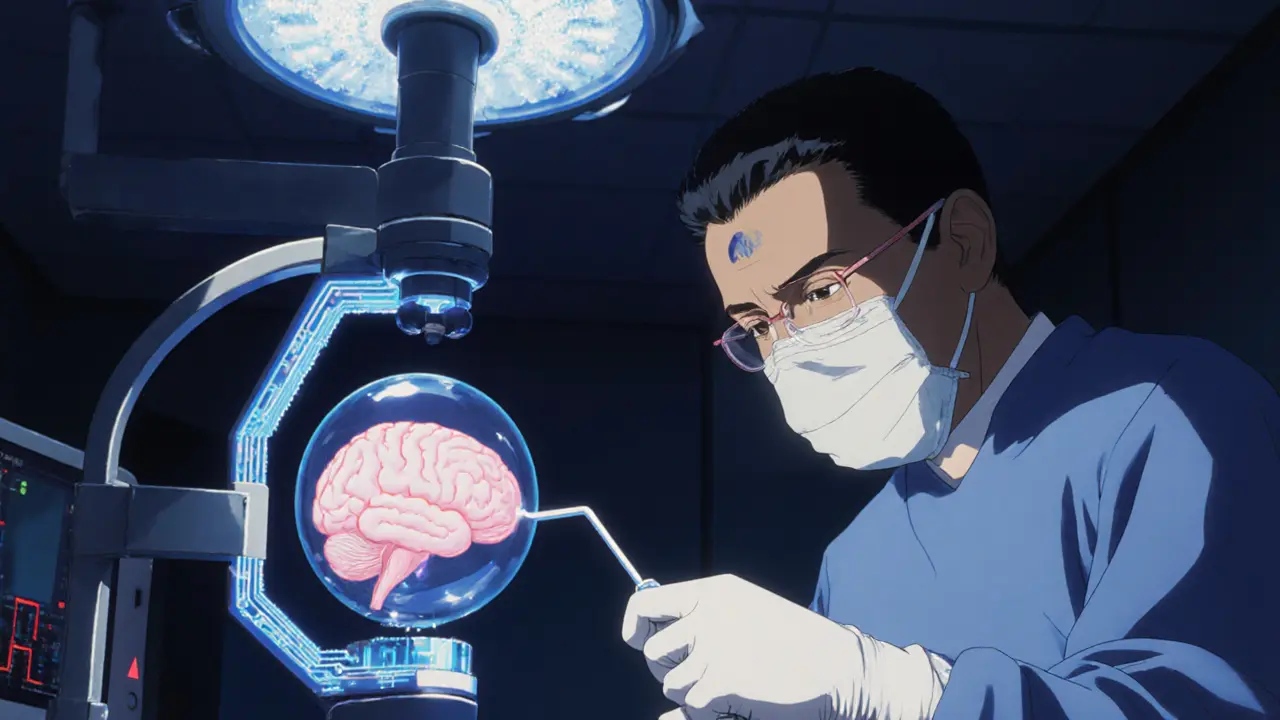When you hear the name Subramanian Kalyanaraman, you’re hearing a story that stretches from the early days of Indian neurosurgery to the cutting‑edge pediatric suites of today’s private hospitals. Two men, decades apart, shared a dedication to pushing the brain’s boundaries - one by introducing stereotactic techniques in the 1960s, the other by treating children with complex spinal and cranial conditions in the 21st century. This article unpacks their journeys, the awards that validated their work, and why the Kalyanaraman legacy still matters for patients and surgeons alike.
TL;DR
- Prof. Dr. S. Kalyanaraman was the first Indian to earn a Ph.D. in Neurosurgery (Royal College of Edinburgh, 1961).
- He introduced stereotactic surgery to India, earning the 1969 Shanti Swarup Bhatnagar Prize.
- Dr. Subramanian Kalyanaraman is a leading pediatric neurosurgeon with a 98% patient‑recommendation rating.
- Their combined work illustrates how Indian neurosurgery grew from pioneering research to specialized child care.
- Key institutions: Institute of Neurology (MMC), Apollo Hospitals, Kanchi Kamakoti Childs Trust Hospital.
Early Life and Education of the Pioneer
Born in the early 1930s in TamilNadu, Prof. Dr. S. Kalyanaraman was the son of a schoolteacher who prized academic rigor. He entered Stanley Medical College in Chennai, graduating with an MBBS in 1956 and an MS in 1959. Recognising the lack of advanced neurosurgical training in India, he secured a scholarship to the United Kingdom, where he trained at the Royal Infirmary and Western General Hospital in Edinburgh.
In 1961, he became the first Indian-and arguably the first in the world-to receive a Ph.D. in Neurosurgery from the Royal College of Edinburgh. The same year he earned Fellowships from both the Royal College of Surgeons of London and Edinburgh, cementing his status as an internationally recognised neurosurgeon.
Pioneering Work in Stereotactic Surgery
Upon returning to India, Kalyanaraman joined the Institute of Neurology at Madras Medical College. Under the mentorship of Prof. B.Ramamurthi-who had founded the institute in 1950-he introduced Leksell and Sehgal stereotactic frames, devices that guide instruments to precise brain coordinates with millimetre accuracy.
These tools let Kalyanaraman perform minimally invasive procedures for conditions that previously required open craniotomy. He tackled involuntary movement disorders, psychiatric illnesses, epilepsy, Parkinsonism, and severe spasticity. One landmark study mapped the pyramidal tract’s exact position within the internal capsule, a finding that clarified why some lesions caused permanent motor deficits while others did not.
His daring experiment-bilateral stereotaxic lesions on mirror‑symmetric brain regions-proved that carefully placed lesions were safe, challenging prevailing dogma that any bilateral intervention was automatically dangerous. This breakthrough opened the door for modern deep‑brain stimulation, a therapy now routine for Parkinson’s disease.
Awards and Impact
The scientific community recognized Kalyanaraman’s contributions with the coveted Shanti Swarup Bhatnagar Prize in Medical Sciences, 1969. The prize, administered by the Council of Scientific and Industrial Research (CSIR), is India’s highest honour for scientific excellence. The award highlighted not only his technical skill but also his original research that expanded global understanding of brain anatomy and surgical safety.
Publications stemming from his work appeared in leading neurosurgical journals of the era, and his team trained a generation of Indian neurosurgeons who later spread stereotactic expertise to other medical colleges across the country.
Legacy and Influence on Indian Neurosurgery
By the early 1990s, Kalyanaraman’s techniques were part of the standard curriculum for neurosurgery residents in India. The Institute of Neurology at MMC became one of the few centres worldwide capable of performing stereotactic procedures, attracting visiting scholars from Europe and the United States.
Patient testimonials from the 1990s still echo his name. In October 1995, a 45‑year‑old patient from Patna named MeeraPrasad underwent removal of a “cricket‑ball‑size” tumor under his guidance, walking out of the operating theatre with a full recovery. Such stories underscore a career that spanned more than four decades, from the nascent post‑independence era to the modern age of image‑guided surgery.
Beyond the operating room, Kalyanaraman’s emphasis on meticulous neuro‑anatomical mapping helped shape India’s regulatory standards for neurosurgical research, influencing how Institutional Review Boards evaluate experimental brain procedures.

Contemporary Dr. Subramanian Kalyanaraman: Pediatric Neurosurgery
Fast‑forward to the 2020s, the name resurfaces in a different but equally impressive context. Dr. Subramanian Kalyanaraman is a pediatric neurosurgeon with over 28years of experience. He earned his MBBS, MS in General Surgery, and DNB in Neurosurgery from premier Indian institutions, then honed his subspecialty skills at Apollo Hospitals, Chennai, where he later headed the Department of Neurosurgery.
Today he practices at Kanchi Kamakoti Childs Trust Hospital in Nungambakkam, a facility known for comprehensive child‑health services. Patient reviews on independent platforms give him a 98% recommendation rating, based on 95 verified testimonials. Parents praise his gentle bedside manner, clear communication, and ability to explain complex procedures in child‑friendly language.
His surgical repertoire includes repair of congenital spinal dysraphism, treatment of pediatric brain tumours, endoscopic third ventriculostomy for hydrocephalus, and functional neurosurgery for drug‑resistant epilepsy. He routinely participates in national workshops, contributes chapters to pediatric neurosurgery textbooks, and has authored papers on minimally invasive techniques for children’s spinal deformities.
Comparing the Two Generations
| Aspect | Prof. Dr. S. Kalyanaraman | Dr. Subramanian Kalyanaraman |
|---|---|---|
| Primary Specialty | Stereotactic & general neurosurgery | Pediatric neurosurgery |
| Era of Practice | 1960s-1990s | 1990s-present |
| Key Institutions | Institute of Neurology, Madras Medical College | Apollo Hospitals; Kanchi Kamakoti Childs Trust Hospital |
| Landmark Achievement | First Indian Ph.D. in Neurosurgery; introduction of stereotactic surgery in India | 98% patient recommendation; pioneering minimally invasive pediatric spine surgeries |
| Major Award | Shanti Swarup Bhatnagar Prize (1969) | Multiple hospital‑level excellence awards (specific names not disclosed) |
The table makes it clear that while the two doctors share a surname and passion for neurosurgery, their focus areas, techniques, and patient populations differ dramatically. Yet both embody a drive to bring world‑class care to Indian patients.
Patient Stories and Testimonials
Patients of the pioneer often recount his calm demeanor and technical confidence. Amrendra Singh, a former patient, once wrote, “He is a perfect gentleman & excellent surgeon.” Such remarks emphasize that surgical brilliance was paired with genuine empathy.
Contemporary patients highlight his ability to comfort children and families. A mother of a 2‑year‑old who underwent endoscopic third ventriculostomy said, “Dr. Kalyanaraman explained everything in a way my child understood, and our anxiety disappeared.” These narratives illustrate a consistent thread: quality care that values the human side of medicine.
Future Directions of the Kalyanaraman Legacy
Modern neurosurgery has moved from stereotactic frames to robot‑assisted, image‑guided platforms. The foundational work of Prof. Dr.S.Kalyanaraman-precise targeting, safety validation, and interdisciplinary research-still underpins today’s deep‑brain stimulation and focused ultrasound therapies.
Meanwhile, Dr. Subramanian Kalyanaraman’s focus on pediatric minimally invasive techniques dovetails with a global shift toward reducing surgical trauma in children. Ongoing collaborations with engineering departments aim to develop child‑specific neurosurgical navigation systems, a logical extension of the stereotactic tradition.
In both cases, the name “Kalyanaraman” has become synonymous with innovation, patient‑first values, and a commitment to raising India’s standing in the worldwide neurosurgical community.
Frequently Asked Questions
Who was Prof. Dr. S. Kalyanaraman?
He was a pioneering Indian neurosurgeon who earned the first Indian Ph.D. in Neurosurgery (Royal College of Edinburgh, 1961) and introduced stereotactic surgery to India, later receiving the Shanti Swarup Bhatnagar Prize in 1969.
What is stereotactic surgery?
It’s a minimally invasive technique that uses a three‑dimensional coordinate system to guide surgical instruments to precise locations in the brain, allowing treatment of disorders without opening large sections of the skull.
What does Dr. Subramanian Kalyanaraman specialize in?
He is a pediatric neurosurgeon focusing on congenital spinal defects, brain tumors in children, hydrocephalus, and functional surgery for epilepsy, currently practicing at Kanchi Kamakoti Childs Trust Hospital.
How did the Kalyanaraman contributions influence modern neurosurgery?
Their work laid the groundwork for today’s deep‑brain stimulation, image‑guided surgery, and robot‑assisted pediatric procedures, making brain surgery safer and more precise worldwide.
Where can I find more information about their research?
Key sources include archives of the Institute of Neurology at Madras Medical College, publications in the Journal of Neurosurgery, and conference proceedings from the Indian Society of Neurological Surgeons.


8 Responses
This is what happens when you stop pretending India can't lead in science. Stereotactic surgery? First Indian PhD in neurosurgery? That’s not luck-that’s grit. The West still acts like they invented brains. Meanwhile, Kalyanaraman was mapping the internal capsule while they were still arguing over whether neurosurgery belonged in the colonies.
I love how this story spans generations. The pioneer didn’t just operate-he changed how we think about precision in medicine. And now his namesake is doing the same for kids, with empathy as the scalpel. That’s not coincidence. That’s legacy.
OMG 😭 THIS IS WHY I LOVE INDIA 🇮🇳✨ Prof. Kalyanaraman didn’t just bring science home-he brought dignity. And now Dr. Subramanian? He’s not just a surgeon-he’s a guardian angel in scrubs for every terrified parent in Chennai. This isn’t just medical history. This is our soul on display.
Let me be clear-this isn’t just about India. This is about how the Global South redefines excellence on its own terms. Stereotactic surgery wasn’t imported-it was adapted, perfected, and made accessible. And now pediatric neurosurgery is being revolutionized by someone who speaks to children like they’re humans, not cases. This is the model the world needs.
Wait-so both guys are named Kalyanaraman? No relation? That’s wild. 😅 But honestly, the fact that two people with the same name, decades apart, both became legends in neurosurgery… feels like fate. Or maybe just how good Indian med schools were back then.
The consistency in values across generations is remarkable. Precision, humility, and patient-centered care-these aren’t just surgical traits. They’re ethical imperatives. The fact that both men upheld them, despite vastly different technologies and patient populations, speaks to the enduring nature of true medical professionalism.
India didn’t need permission to be great. They just did it.
What blows me away is how this legacy is still growing. The pioneer didn’t just invent techniques-he built a culture of inquiry. And the current Dr. Kalyanaraman? He’s not just continuing it-he’s expanding it into pediatric care with tech that didn’t exist in the 60s. This is how medicine evolves: not with flashy gadgets alone, but with people who refuse to settle for ‘good enough.’ And the 98% recommendation rate? That’s the real Nobel Prize.